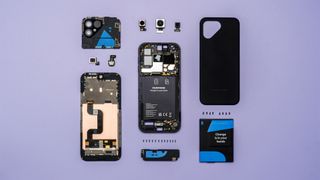Fairphone 5 puts Apple, Google and Samsung to shame in one major way
Netherlands-based eco-friendly phone maker Fairphone is back at it again with the launch of the Fairphone 5, nearly two years after its predecessor, promising even more eco-friendly construction, more user-replaceable parts and industry-leading long-term technology. software support that puts its biggest rivals to shame.
Fairphone has carved out a niche in the mobile market by being the brand, when it comes to ethical and environmentally conscious production and sale of smartphones. Longevity is a big part of the Fairphone formula, with extensive software support and a high degree of user repairability, plus the offer of component-level hardware upgrades so you don’t have to replace an entire device to gain access to a nicer device. screen or a better camera.
Of course, the fair phone 5 embodies all of these qualities, but raises the bar on both its hardware and software proposition, while challenging the wider mobile industry; lead by example in areas such as sustainability and fair pay for employees in the telephone supply chain.
At the hardware level, the Fairphone 5 is the first in the series to make the jump from LCD to OLED for its display technology, with a 6.46-inch 90Hz Full HD+ panel that should mark a notable improvement in the Fairphone viewing experience. There’s also a trio of new higher resolution 50MP cameras, with a Sony IMX800 sensor (used in phones like the excellent Xiaomi 13) backed by OIS (optical image stabilization) taking the lead, along with an ultra-wide and a punch- hole selfie snapper . Fairphone says a lot of work has gone into optimizing the camera experience on the Fairphone 5 to ensure better performance, especially in low-light conditions.
Here’s the full breakdown of the specs:
| Header Cell – Column 1 | |
|---|---|
| Dimensions: | 162 x 75.5 x 10.5mm |
| Weight: | 212 grams |
| Screen: | 6.46-inch 20:9 Full HD+ 90Hz OLED protected by Gorilla Glass 5 |
| Audio: | Stereo speakers, Bluetooth 5.2 |
| chipset: | Qualcomm QCM6490 |
| RAM: | 8GB (LPDDR4X) |
| Storage: | 256 GB (UFS 2.2) + microSD (up to 2 TB) |
| Operating system: | Android 13 |
| Primary camera: | 50MP, f/1.88 with OIS (Sony IMX800) |
| Ultra-wide camera: | 50 MP, f/2.2 with 121º field of view (Sony IMX858) |
| Front camera: | 50 MP with 90 degree field of view (Samsung ISOCELL JN1) |
| Battery: | 4,200 mAh (user-replaceable) |
| To upload: | 30W wired |
| To colour: | Sky blue, matte black, transparent |
The modular nature of the phone’s components means you can swap out the camera or even the USB-C port if needed, but this extends to the battery too: a user-replaceable 4,200mAh cell mated to 30W wired fast charging says Fairphone lasts 12 hours and charges to 50% in less than 30 minutes. Fairphone even promises a selection of a total of eleven components that users can swap out if they need to be replaced or underperform.
As for durability, the Fairphone 5 MIL-810H is not only shock and drop resistant, it’s also IP55 certified, meaning it’s slightly more water resistant than its predecessor. Fairphone even revealed during its launch Q&A that some individual components actually have higher ingress protection (the USB-C port, for example, is IP67 rated), but as a whole the phone is IP55 rated.
Perhaps the biggest win for the end user is the software promise. We commended Samsung for beating Google in the Android camp, offering four years of OS updates and five years of security updates on most of its phones, while Apple’s iPhones have had as many as six OS updates in the past. received updates in their lives. Fairphone is now upping the ante by promising five years of OS updates and eight to 10 years of total software support, meaning the company won’t technically drop the Fairphone 5 until 2033. Executives also spoke to the timeliness of updates at launch, meaning users should expect OS updates sooner than in previous years.
As well as being a groundbreaking move to ensure users have a functional and secure phone for longer than the competition, this is only really possible due to the unusual chipset choice Fairphone has gone for with its latest device. While the company has continued to work with Qualcomm, unlike competitors who put Snapdragon-branded silicon in their smartphones as standard, the Fairphone 5 uses the company’s technology instead. QCM6490. While the branding may not be as tight, this octa-core chip actually comes from Qualcomm’s IoT product line, so it’s purpose-built to allow for longer-term software updates than comparable Snapdragon mobile chips (even if Fairphone is even more support then only promises Qualcomm’s own 2028 cutoff).
As said by WinFuturePerformance shouldn’t differ too much from a Qualcomm Snapdragon 778G, which – if you also consider the other specs on the table – puts the Fairphone 5 somewhere near the Nothing Phone 1 and Samsung Galaxy A54; a well-rounded lower mid-range offering, but with all its unique, environmental-focused selling points.
The price of progress
Given the spec sheet, a price of £649 / €699 (around $825 / AU$1,270) is certainly on the high side in terms of a spec-for-spec comparison, but is more justified when you consider the unique proposition the Fairphone 5 offers. offers. ahead. The cost covers the R&D costs of building a modular phone with user-replaceable parts, built in offerings that are not typically tailored to such production styles.
It’s a price that allows Fairphone to offer an extended five-year warranty, create a product that is zero electronic waste and comes from Fairtrade sources for the precious metals used. It even provides living wage bonuses for employees within the Fairphone 5 supply chain; all factors that we never really hear about from other phone manufacturers.
As for when you can get your hands on one, pre-orders started at launch on August 30, with availability in Europe and the UK from September 14. Availability in the US is still up in the air, with the company claiming it is “focusing on their customer base in Europe first” but still “exploring and considering the US” as well.
For reference, the Fairphone 4 came to the US, but only in July this year and through distributor Murena, whose version of the phone comes with e/OS, not conventional Android; complete with the Google Play Store. It’s unclear at this stage if Fairphone will follow a similar path with the Fairphone 5, when it comes to a US rollout.
The arrival of the Fairphone 5 does not mean the end for the Fairphone 4 either. The company will continue to sell its 2021 phone at a discounted price of €529, while also continuing to offer components and software updates for the device.


